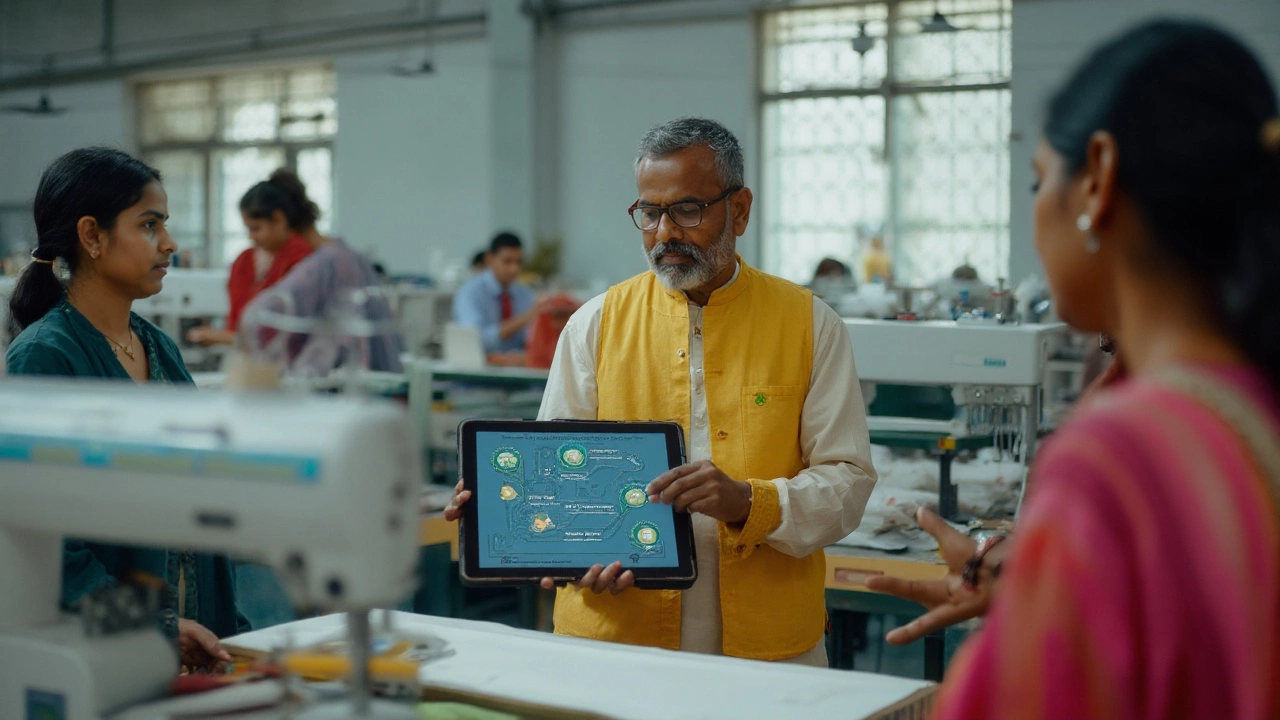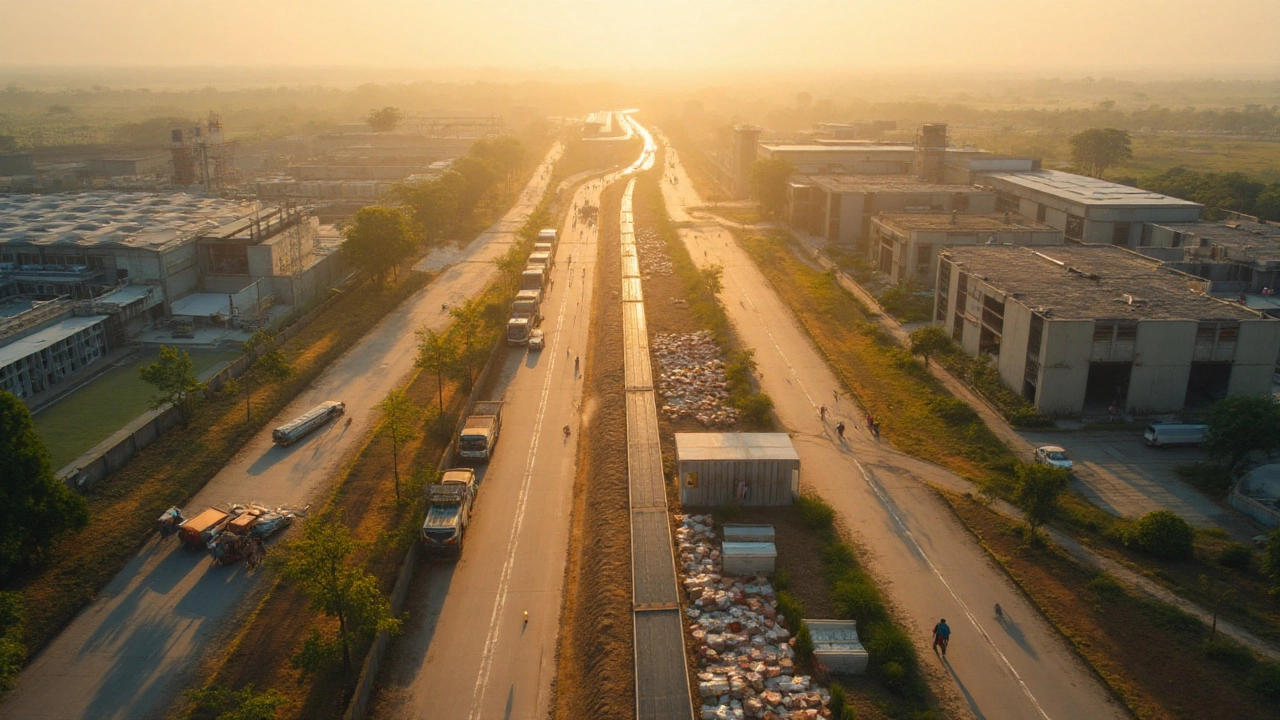If you clicked to figure out what India’s new textile policy actually is, you’re not alone. The term gets thrown around like there’s a single glossy document that changed everything. There isn’t. The “new policy” in 2025 is a stack of powerful schemes, trade moves, and standards that together push the industry toward man-made fibers, technical textiles, scale, and compliance. Here’s what that bundle looks like in practice, what it pays, who qualifies, and how to make it work for your business.
- There’s no single all-in-one policy paper; it’s a package: PLI (for MMF and technical textiles), PM MITRA mega parks, the National Technical Textiles Mission, export rebates (RoSCTL/RoDTEP), and new quality control orders.
- Money is real: the PLI outlay is about ₹10,683 crore; PM MITRA funds seven integrated parks; NTTM funds R&D and adoption of technical textiles. States add their own incentives on top.
- Focus areas: man-made fibers (polyester/viscose value chain), technical textiles, integrated supply chains, quality standards (BIS/QCOs), and clean, scalable manufacturing.
- If you make cotton apparel, PLI won’t help. Look at PM MITRA parks for infra benefits, RoSCTL for export rebates, and state policies for capex interest subsidies.
- Action plan: check product eligibility, run a 5-year payback model, pick a park/state with the best landed cost, and get ahead of QCO/BIS compliance.
What the “new textile policy” really means in 2025
People expect a shiny policy PDF. What you actually have is a set of moving parts that together shape where the money and momentum go. The Ministry of Textiles, via Cabinet decisions announced through the Press Information Bureau (PIB) and formal notifications, has leaned hard into three pillars: scale, synthetics/technical, and standards.
Here’s the core of it, in plain English:
- India textile policy 2025 isn’t a single law; it’s the sum of current flagship schemes and rules.
- Production-Linked Incentive (PLI) nudges investment into man-made fiber (MMF) garments/fabrics and specified technical textiles. It rewards incremental turnover of approved product lines.
- PM MITRA builds seven mega parks with plug-and-play infra to reduce logistics and utilities cost while clustering spinning-to-garment in one campus.
- The National Technical Textiles Mission (NTTM) funds R&D, standards, and market adoption for high-value textiles used in healthcare, geo, agro, defense, and mobility.
- Export incentives-RoSCTL (garments/made-ups) and RoDTEP (others)-offset taxes not refunded elsewhere. They help on pricing, especially for price-sensitive markets.
- Quality Control Orders (QCOs) and BIS standards are rolling out across parts of the MMF and technical textile value chain. Non-compliance can block imports, production, or sales.
Trade policy matters too. India has working free trade deals with the UAE (CEPA) and Australia (ECTA), which cut duties for many textile lines. Talks with the EU and UK are active, but timelines have wobbled; treat those as upside options, not certainties. Meanwhile, global buyers are raising the floor on traceability, chemical management, and energy intensity-standards are becoming market access requirements, not nice-to-haves.
Where is the industry being pushed? Toward MMF and technical textiles (where global demand is deeper and less volatile than cotton fashion), toward integrated parks (to shave costs and speed), and toward documented quality and compliance (to keep exports sticky and reduce domestic dumping of low-grade inputs).
The key schemes, benefits, and how they fit together
Below is the quick map of the main central government levers you’ll hear about. Figures are from official announcements by the Ministry of Textiles and PIB, plus scheme notifications. Use them to anchor your capex and pricing math.
| Scheme / Policy | Outlay & Window | What it Targets | Who Benefits | Status/Notes |
|---|---|---|---|---|
| PLI for Textiles (MMF & Technical Textiles) | ~₹10,683 crore; announced 2021; selection waves in 2022-24 | Incremental sales of specified MMF garments/fabrics and technical textiles | Approved firms with committed capex and product lines on the notified list | New windows are not routinely open; beneficiaries executing capex; watch for re-alignments |
| PM MITRA Parks | Central support ~₹4,445 crore across 7 parks; 2023-2028 | Integrated textile parks: common infra, utilities, ETPs, logistics | Large and MSME units locating inside the selected parks | Locations announced; SPVs formed with states; plot allotments via park authorities |
| National Technical Textiles Mission (NTTM) | ~₹1,480 crore; launched 2020; extended | R&D, standards, trials, market development for technical textiles | Manufacturers, institutes, startups in technical textile domains | Calls for proposals; standardization with BIS; buyer-seller pilots ongoing |
| RoSCTL (exports of garments & made-ups) | Rates notified by DGFT; validity earlier extended to Mar 2026 | Rebate of state/central taxes/levies not refunded elsewhere | Exporters of apparel and made-ups | Claim via ICEGATE; rates vary by HS code; subject to periodic review |
| RoDTEP (other exports) | Budgeted annually; rates notified by DGFT/CBIC | Remission of embedded taxes for a wide range of products | Exporters outside RoSCTL coverage | Mandatory E-scrip, item-specific caps; check latest rate schedule |
| QCOs & BIS Standards (MMF & Technical) | Not budgeted; regulatory | Mandatory quality compliance for select fibers/yarns/fabrics | Producers, importers, and users of covered lines | Phased enforcement via MoT notifications; non-compliance can stop production/sales |
| ATUFS (legacy) | ₹17,800+ crore sanctioned historically | Capital subsidy for tech upgradation | Units sanctioned under ATUFS | Closed for new sanctions; settlement of committed liabilities continues |
Three practical takeaways from that matrix:
- PLI is narrow but rich. If you’re outside MMF/technical lists, don’t burn time chasing it. Use state incentives and park infra instead.
- PM MITRA is the big equalizer. Even a mid-sized unit can claw back 3-6% cost via infra, utilities, waste treatment, and internal logistics if the park is run well.
- Standards aren’t optional. QCOs tied to BIS standards will make raw material choice and vendor vetting a weekly job, not an annual audit.
State policies stack on top. Gujarat, Tamil Nadu, Maharashtra, Uttar Pradesh, and Telangana-among others-offer capex subsidies, interest subvention, power tariff support, and stamp duty refunds for textiles. The best deals usually require you to:
- Invest above a minimum threshold.
- Locate in designated zones or parks.
- Hit employment targets.
If you’re exporting, keep one eye on trade deals and product rules of origin. Australia and the UAE are already live; many MMF lines benefit from reduced duties. For the EU/UK, assume buyer due diligence will push you to show chemical compliance (ZDHC-like norms), wastewater data, and traceability for man-made fibers.

How to act: eligibility checks, quick math, and a simple path to benefits
Use this as your action playbook. It’s designed for owners, CFOs, and export managers who need decisions, not buzzwords.
Step 1: Map your product to the right bucket
- MMF Apparel/Fabric: Think polyester, viscose, blends. PLI applies only if you’re on the notified list and part of approved applications.
- Technical Textiles: Meditech, Geotech, Agrotech, Protech, etc. NTTM grants and standards work here; some PLI lines apply.
- Cotton Apparel: No PLI. Focus on PM MITRA park benefits, RoSCTL, and state schemes.
- Yarns/Fibers: QCO/BIS compliance risk is high. Vet suppliers and test lots.
Step 2: Do a 5-year landed cost and incentive model
- Capex: land (or lease), shed, machinery, ETP/ZLD share if in park, power backup.
- Operating: power (grid + DG), steam, water, effluent, chemicals/dyes, labor, logistics.
- Policy credits: PLI (if eligible), RoSCTL/RoDTEP, state interest/capex subsidy, electricity duty waiver, MITRA infra savings.
Rule of thumb: A good PM MITRA park with reliable power/steam and an efficient ETP can cut 3-6% off conversion costs for wet processing-heavy operations; 1-3% for cut-and-sew alone. RoSCTL rates on apparel/made-ups often sit in the low single digits but swing product by product-always pull the latest schedule from DGFT before pricing a big order.
Step 3: Pick a location using three filters
- Skill and cluster effects: For knits, Tiruppur-like ecosystems are hard to beat. For MMF, Surat and Silvassa have depth. Technical textiles often cluster near auto, medical, or infra hubs.
- Park vs standalone: Choose a park if you need heavy utilities, quick approvals, and common facilities. Go standalone if you need custom layouts, specialty effluent handling, or existing vendor proximity.
- State incentives: Ask for a written calculation from the state department. Don’t rely on brochures. Get power tariffs, refund slabs, and timelines in writing.
Step 4: Compliance plan (don’t wing this)
- QCO/BIS: Make a two-column list-items you produce, items you buy. Mark which HS codes have active or notified QCOs. Set a testing cadence and approved labs.
- ESG and wastewater: If buyers ask for ZDHC or Higg data, treat it as a sales enabler. Park ETPs help, but you still need process control.
- Labor: The four national labor codes are not uniformly in force across states yet. Follow your state’s current rules, and plan for migration to codes.
Step 5: Application routes, in practice
- PLI (Textiles): If you’re not already approved, monitor the Ministry of Textiles for any re-openings or sub-scheme tweaks. Coordinate with your industry association for early signals.
- PM MITRA: Identify the specific park SPV (state + MoT). Register interest, get a plot, and secure utilities. Your real “application” is the land/lease and building plan approvals within the park.
- NTTM: Track calls for proposals; team up with an institute if your R&D bandwidth is thin.
- RoSCTL/RoDTEP: Lock your HS codes, ensure EDI compliance, and sync your ERP to file claims accurately via ICEGATE. Test on a small shipment, then scale.
Quick example: does PLI move the needle?
Imagine a mid-size MMF garment unit scaling from ₹250 crore sales to ₹500 crore in five years with PLI-eligible lines. If average eligible incremental sales are ₹40 crore per year and incentive is, say, 6% (illustrative; actual rates vary by year and performance), that’s ₹2.4 crore a year before caps and compliance checks-₹12 crore across five years. Now net that against the extra capex and the working capital needed to feed growth. If your park location also saves 2% on conversion cost, your effective payback can drop by 1-2 years. If you’re not on PLI, the park and state incentives still get you most of the way on payback, just without the annual cash credit.
Another example: technical textiles pivot
A coated geotextile maker planning a ₹60 crore line can combine NTTM-supported testing and standardization with a PM MITRA plot and a state capital subsidy (say 10-15% with caps). If RoDTEP quietly adds 1-2% to export pricing headroom, and logistics shrink inside the park, you can squeeze enough margin to pass strict customer audits while staying price-competitive.
Checklists, decision trees, and what to watch next
Compliance and eligibility checklist (print this):
- Product mapping: HS codes confirmed; PLI/NTTM eligibility checked.
- Export incentives: RoSCTL/RoDTEP schedules pulled for current fiscal; ERP tuned to auto-capture claims.
- Standards: QCO/BIS map updated; vendor declarations and test reports filed; lot testing calendar set.
- Location: PM MITRA park contacted; plot/lease terms, utility tariffs, and ETP fees received in writing.
- State incentives: Sanction letter template reviewed; timelines and documentation list agreed.
- ESG: Chemical inventory audited; wastewater parameters tracked; buyer-required certifications scheduled.
- Finance: 5-year cash flow with incentive scenarios; sensitivity on power tariffs and cotton/MMF spread.
Simple decision tree:
- Are your main products MMF/technical and on the notified PLI list? → Yes: chase PLI (if open) and pick a PM MITRA park that fits your buyers. → No: go straight to park + state incentives + export rebates.
- Do you rely on fibers/yarns covered by QCOs? → Yes: lock in BIS-compliant suppliers; budget for testing. → No: still pre-qualify vendors; standards will expand.
- Are 30%+ of your sales exports? → Yes: build pricing with live RoSCTL/RoDTEP rates; check FTA duty lines for UAE/Australia. → No: focus on domestic standards and park logistics savings.
Pitfalls to avoid:
- Assuming PLI is evergreen. It’s not. If you missed the window, plan without it.
- Underestimating ETP costs. Common facilities help, but your effluent profile drives your bill.
- Treating QCO/BIS as paperwork. Customs and inspectors can halt your line if you’re out of spec.
- Ignoring state timelines. Subsidies that pay in year 3 aren’t worth it if cash is tight today. Model timing risk.
What to watch next (as of September 2025):
- Any reopening or reshaping of PLI tranches for garments or technical textiles.
- New QCO notifications expanding the list of mandatory standards in MMF and technical segments.
- Park-level progress: which PM MITRA parks are handing over plots, which have power/steam live, and which SPVs are clearing approvals fast.
- Trade deals: movement on EU/UK. Don’t price future orders assuming zero duty until you see the tariff schedule.
Primary sources worth following: Ministry of Textiles notifications and PIB releases for scheme updates; DGFT for RoSCTL/RoDTEP rates; CBIC/ICEGATE procedures for e-scrips; BIS for standards and testing protocols; your state’s industries department for local incentives.

Mini‑FAQ, personas, and next steps
FAQ
- Is there a single “New Textile Policy 2025” document? No. The current direction comes from active schemes (PLI, PM MITRA, NTTM), export remissions, and standards via QCO/BIS.
- Can a cotton T-shirt exporter get PLI? No. PLI is for specified MMF garments/fabrics and technical textiles only.
- Are RoSCTL rates fixed for years? No. They’re notified and can be reviewed. Always check the current DGFT schedule before final pricing.
- Do I need BIS certification if I import polyester staple fiber? If that PSF grade is under a QCO, yes-BIS compliance is mandatory, subject to any notified exemptions or timelines.
- Can MSMEs benefit without PLI? Yes. PM MITRA park infra, state subsidies, RoSCTL/RoDTEP, and easier cluster logistics often deliver 3-6% cost gains.
Next steps by persona
- Exporter (apparel/made-ups): Pull live RoSCTL rates, map HS codes, and bake them into your quotes. If your buyers will accept MMF blends, run a margin test with current duty lines to the UAE/Australia.
- MMF fabric maker: Create a QCO/BIS compliance binder-supplier declarations, lab test reports, and batch traceability. Price in testing costs per lot.
- Technical textiles startup: Pair with a reputed institute to respond to NTTM calls; set up in a park that offers lab access and short logistics to your end-use sector.
- Foreign investor: Shortlist 2-3 PM MITRA parks; ask each SPV for utility tariffs, land lease norms, and approval timelines in writing. Compare with an established private park to test the business case.
Troubleshooting
- “My PLI application window is closed.” Build your plan around PM MITRA + state incentives + export remissions. Treat any future PLI round as a bonus.
- “Customs held my fiber consignment.” Check if it’s under QCO; if yes, ensure BIS compliance and paperwork match the notification. Use a tested customs broker who handles MMF regularly.
- “Park plots are delayed.” Don’t pause the whole project-secure off‑park approvals and long‑lead machinery orders. Keep a fallback location; often a private park can bridge timelines.
- “Buyers now ask for wastewater data.” Instrument your ETP inflow/outflow and share month-on-month charts. If you’re in a PM MITRA park, ask the SPV for audited plant-wide data to supplement yours.
If you take one thing from this: treat policy as a toolkit, not a headline. Pick the pieces that match your product and cash flow, then run the numbers. The firms that do this well don’t wait for the perfect scheme-they stack infra, standards, and the right rebates, and let the compounding work for them.





Write a comment